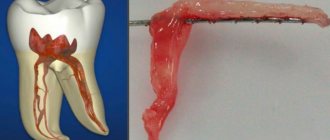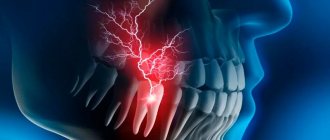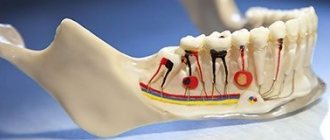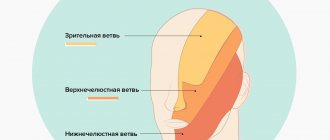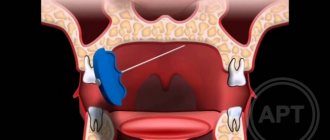Causes of toothache
The main causes of toothache are caries, pulpitis and other inflammatory processes, as well as the growth of wisdom teeth.
The most common cause of toothache is caries; it starts with a small spot on the tooth and can destroy the tooth completely.
The appearance of caries is caused by pathogenic bacteria that live on the teeth and feed on food debris. The product of their vital activity is acid, which gradually destroys tooth enamel. A hole appears, which increases in size and begins to hurt. When the destruction process reaches the nerve, the pain becomes very severe.
Important! Pulpitis is an inflammation of the soft tissue of the tooth (pulp). Advanced caries leads to this disease. Bacteria penetrating through the carious cavity infect the pulp and cause inflammation. Pulpitis causes severe pain and requires immediate treatment.
Inflammatory processes sometimes affect even those teeth in which the nerves have already been removed. When this happens, a person may feel pain not in the problem tooth, but in the entire oral cavity. Sometimes it can even be difficult to determine where exactly the unpleasant sensations come from. Another common cause of toothache is the eruption of third molars – wisdom teeth. They are considered the most problematic teeth, since their eruption and growth are rarely without difficulties. This process is often accompanied not only by unpleasant sensations in the mouth, but also by fever, weakness, enlarged lymph nodes, and headache. All organs of the human body are interconnected, so a disease or injury to one of them often causes pain in neighboring ones. The same applies to teeth.
What diseases can cause severe toothache?
Acute toothache can be a companion to many diseases of the oral cavity (and not only). Here are the most common ones.
Caries
A carious cavity occurs as a result of the process of demineralization and destruction of hard tooth tissues. Most often, pain appears after eating sour or sweet, cold or hot food.
Deep caries, which is accompanied by complete tooth destruction, turns into pulpitis and then pain occurs even without exposure to external irritants.
In some patients, the disease develops asymptomatically: pain appears only at the final stage, when the tooth cannot be saved.
Pulpitis
The source of pain is the neurovascular bundle, which is located inside the tooth. If it becomes inflamed, a person will know about it first by aching, and then by acute toothache, disturbing even at rest.
The pulp suffers, for the most part, from the activity of pathogenic microorganisms, especially streptococci and staphylococci. And untreated caries only makes the situation worse. Another cause of pulpitis is tooth trauma (fractures, enamel chips, crown fractures).
The negative influence of temperature or chemical factors is the most rare cause of the problem.
Gingivitis
The disease is characterized by inflammation of the gums (or a specific area). It is provoked by the same dental plaque, which, deposited in places that are difficult to reach for cleaning teeth, turns into tartar.
Gingivitis is accompanied by swelling and redness of the gums, bleeding and pinpoint hemorrhages, hyperemia, bad breath, and less commonly, the appearance of erosions.
More susceptible to it than others:
- children and adolescents whose teeth are actively growing,
- women taking oral contraceptives,
- women during menstruation,
- patients taking immunosuppressants,
- lovers of tobacco products, as well as spicy and hot food.
Stomatitis
A rather unpleasant phenomenon characterized by inflammation of the oral mucosa of various etiologies. If redness and swelling are observed, we can talk about catarrhal stomatitis, blisters - herpetic, ulcers - aphthous or ulcerative. In addition to pain, the patient may experience a burning sensation, especially after eating.
Stomatitis can be independent and accompany other diseases. They often accompany pemphigus, systemic scleroderma and streptoderma, and immunodeficiency states. But more often they appear on their own due to mechanical injuries, uncomfortable prostheses, and infections entering the body.
Periodontitis
With periodontitis, the tissues surrounding the tooth become inflamed, resulting in the destruction of the periodontal junction. In this case, the gums bleed and become inflamed, and sometimes abscesses and fistulas occur. Cavities are formed - periodontal pockets in which pus accumulates. Teeth become loose, to the point that they may fall out. An unpleasant odor appears from the mouth.
Periodontitis
The connective tissue (periodontal) surrounding the tooth root at the apex can also become inflamed and painful.
Usually this disease accompanies advanced caries, manifesting itself:
- pathological tooth mobility,
- acute pain in its area, intensifying at the slightest touch,
- swelling of the gums,
- swelling of the cheeks,
- increase in body temperature.
Complications of periodontitis:
- cysts and granulomas,
- perimaxillary abscesses,
- phlegmon,
- osteomyelitis,
- fistulas
The disease is insidious in that it can occur painlessly in the initial stages. In this case, the bone around the root slowly and imperceptibly dissolves, forming a granuloma (small sac) or a cyst - a large cavity.
If periodontitis is not treated, complications from internal organs may occur: glomerulonephritis, rheumatic lesions of the joints and heart valves.
Periostitis (flux)
Although “flux” does not sound so scary, in reality the disease is serious. This is an inflammation of the periosteum (periosteum) of the jaw body and the alveolar processes in which the teeth are located.
Periostitis begins with swollen gums, gradually spreading to the cheeks, lips, infraorbital or submandibular area.
The development of pathology can be started by injuries, inflammatory lesions of bone or soft tissue, rheumatic diseases, allergies, a number of specific infections, and less commonly, bone tumors.
Trigeminal neuralgia
Patients often complain of acute pain in a “dead” tooth.
This happens when the trigeminal nerve is affected, one of the pairs of cranial nerves that is responsible for the sensitivity of the face in general, the eyes and jaws in particular, as well as the activity of the masticatory muscles.
Trigeminal neuralgia can be caused by vascular pathologies, infections, cerebral tumors, changes in skull structures due to trauma, persistent otitis media, sinusitis, and dental deformation.
Temporomandibular joint dysfunction
This joint, like all others, is susceptible to injury and disease. Its dysfunction can be caused by unsuccessful yawning or prolonged opening of the mouth. As a result, it becomes difficult to open and close the mouth, causing crunching and clicking sounds. The pain intensifies when chewing, becoming unbearable, radiating to the temple and jaw.
Tumor
In addition to acute pain, jaw swelling may be accompanied by decreased sensitivity, tingling, heaviness in the jaw muscles or paralysis. Tomography (CT or MRI) will help identify it.
Eruption of wisdom teeth
Often, when the figure eight erupts, its “hood” becomes inflamed. This disease is called pericoronitis. It often occurs when a tooth erupts incorrectly. Pain can also occur due to contact of an incorrectly growing “eight” with a neighboring tooth. ENT diseases
These pathologies have nothing to do with teeth, but can cause acute toothache:
- otitis media,
- acute sinusitis of the upper jaw (sinusitis),
- allergic sinusitis.
Toothache radiates to head
For many people, toothache causes headaches. Most often, the side of the head on which the problem tooth is located begins to hurt. Different teeth provoke pain in different areas of the head:
- molars cause pain in the parietal or occipital part of the head;
- the fangs give off throbbing pain in the temporal part;
- incisors provoke pain in the forehead;
- Lower teeth can often cause pain throughout the entire head at once.
If a toothache radiates to the head, it is not always sharp and obvious. Some patients suffer from chronic headaches without even realizing that they are caused by a dental problem. This type of pain is called dental pain. The mechanism for the appearance of pain of a dental nature is irritation of the endings of the second and third branches of the trigeminal nerve and the autonomic facial nerve ganglia. The cause of migraine can be not only inflammatory processes of dental tissues, but also malocclusion. When the jaws close incorrectly, the temporomandibular joint receives additional stress and over time this leads to dull pain in the ear, temple, crown or back of the head.
A pinched triangular nerve caused by a malocclusion can cause severe headaches.
Many patients have noticed that after tooth extraction they often experience a headache. This phenomenon is quite normal, because tooth extraction is a rather traumatic surgical procedure. When removing a tooth, it is impossible not to damage the mucous membrane, gums and bone tissue, and this leads to headaches. The head may also hurt from the anesthesia that the dentist uses during the procedure. Usually the next day after surgery the headache stops hurting. What to do if a tooth gives you a headache? Taking painkillers may provide temporary relief. But at the first opportunity, you should consult a dentist to identify the cause of the disease and eliminate it.
What to do
To make you feel better, you need to contact a dentist, who will determine the cause of the pathology, analyze the symptoms and, if necessary, refer you to a neurologist. For treatment, anti-inflammatory drugs or symptomatic drugs are usually prescribed. It is very important to follow all the specialist’s recommendations to prevent the development of complications.
To relieve pain in the temples, it is necessary to take anti-inflammatory and steroid drugs or drugs that include Ibuprofen, since such therapy is safer than using Analgin, Aspirin and others. This treatment helps improve the patient’s general condition (weakness, nausea, vomiting, pain) and block the development of pathological processes.
The medicine Imet effectively relieves headaches; it contains 400 mg of Ibuprofen, this is enough to quickly remove unpleasant symptoms, since the effect of the drug begins a few minutes after administration. Ibuprofen also works well if your headache is accompanied by stomach cramps.
All problems are easier to treat in the initial stages, so it is necessary to undergo a dental examination every six months to prevent caries and other pathologies. It is also important not to forget about oral hygiene.
The development of neuralgic processes can be triggered by injuries, stress, tumors and other pathologies. All this leads to pain in the temples. To prevent it, you need to lead a healthy lifestyle, increase your immunity, avoid strong emotions and general hypothermia of the body.
Toothache radiates to temple
It happens that your tooth hurts and your temple hurts. As mentioned above, pain in the temple usually occurs when the fangs become inflamed. Another reason may be inflammation of the temporomandibular joint, in which the temple also begins to hurt. This inflammation can occur if a person has an incorrect bite or chews food on one side for a long time. Dentists recommend distributing the load on both sides when chewing food. But if there is at least one diseased chewing tooth, a person tries to eat so that food does not fall on him. As a result, the entire load falls on one side, forcing the temporomandibular joints to work twice as hard. To avoid this, it is necessary to promptly treat or remove diseased teeth.
Attention! Painful pulsation in the temple can be caused by the growth of the upper wisdom teeth. In this case, swelling of the gums around them is observed. From the temporal region, pain can spread to the entire head.
Pain when the third molar erupts is normal. To reduce it, you should drink an analgesic, and also periodically rinse your mouth with a decoction of chamomile, sage, calendula, eucalyptus, soda solution or propolis tincture. If the wisdom tooth cannot erupt in any way, and the pain and swelling of the gums do not disappear, but only intensify, you need to consult a doctor. The dentist will make an incision in the gum and free the tooth. This operation is performed under local anesthesia and does not take much time.
The gingival hood excision method is performed to help the wisdom tooth erupt.
Diagnostic and treatment methods
An accurate diagnosis is made by a dentist based on the results of the examination and additional examinations. You may need X-rays of the jaw, computed tomography, as well as orthopantomography - a common technique for visualizing the stage of carious lesions and assessing the condition of fillings and crowns. The following methods are used for treatment:
- correction of bite using orthodontic structures (plates, braces, mouth guards);
- surgery to remove tumors, damaged teeth and nerves, and to treat caries;
- prosthetics, installation of implants.
If the doctor prescribes surgical treatment, conservative methods and medications are ineffective. They will help temporarily reduce the pain, but then the disease will progress. It is important to remove the main focus of the disease, cleanse the pathological area of microorganisms, pus and other substances, and then pay attention to proper recovery. If necessary, the dentist may prescribe additional routine examinations some time after successful treatment.
Toothache radiates to jaw
Some patients ask the doctor: can a tooth cause jaw pain? Yes, this problem is familiar to any dentist. Its cause may be a serious dental disease such as osteomyelitis. Osteomyelitis of the jaw is a purulent-inflammatory process of the bone of the upper or lower jaw. It occurs as a result of infection of bone tissue by bacteria. The reason for this is advanced, untreated caries. With osteomyelitis, a person's jaw begins to hurt severely. This disease is fraught with serious complications and requires urgent treatment. Another cause of pain is the same wisdom teeth. When the lower wisdom teeth erupt, not only they, but the entire jaw often hurt. Jaw pain is often observed in people who wear braces and dentures. A brace system or denture puts pressure on the dentition and can cause quite unpleasant sensations in the jaw. At first, when wearing these structures, pain is the norm, because the jaws are not yet accustomed to them. When installing braces or dentures, dentists usually warn patients about this. But if wearing the prosthesis is very painful or the discomfort does not go away for a long time, you need to consult a doctor: perhaps the prosthesis is installed incorrectly or complications have arisen.
Bracket is a system on the lower jaw.
Toothache radiates to ear
It happens that toothache radiates to the ear. A common cause of this is pulpitis. When pressing on a sore tooth, the discomfort in the ear intensifies. From the ear, pain can spread to the entire temporal region. Pain in the ear is often observed after tooth extraction. They arise due to trauma to soft tissues during surgery and usually disappear within two days. If during this time the pain does not disappear, but only intensifies, this indicates the occurrence of complications. Inflammation of the trigeminal nerve also leads to ear pain. If the cause of such inflammation is not related to dental diseases, you should seek help from a neurologist. Inflammation of the upper jaw joint, malocclusion, and, of course, the growth of third molars also cause pain radiating to the ear. In this case, temporary help can be provided by rinsing with herbal decoctions or taking painkillers. But this cannot eliminate the cause of the pain, so a trip to the dentist is inevitable.
Toothache leads to a number of inconveniences: it is difficult to open your mouth, an unpleasant odor occurs due to the sprinkling of bacteria, pain in the ear...
Pain after caries treatment
Immediately after filling a tooth, pain may occur for the following reasons:
- temperature changes (cold food, hot drinks);
- pressure of the filling on the pulp (if the carious cavity was located very close to the nerve).
Increased sensitivity to cold and hot usually goes away after a couple of days. The pain due to the pressure of the filling on the pulp should disappear within a month, as a protective layer of dentin is produced. If the pain lasts longer than 4 weeks, go to the doctor.
If pain did not occur immediately, but several weeks after filling, then the causes are complications, such as:
- the presence of remains of caries-affected tissue under the filling, which provoked the development of pulpitis;
- crooked filling;
- poor oral hygiene, which caused secondary caries.
Note! Go to the doctor if the pain that occurs after filling lasts longer than a month, and also if the symptom does not appear immediately, but after several weeks.


